Hefei Lord Bao Park - English version
- Ale_Iva
- Aug 5
- 9 min read
I recently had the opportunity to explore a part of the world that was still totally unknown to me: China. This trip taught me a lot and gave me experiences that I will never forget. Today I want to share with you one of these cherished memories...
By Alessandra Ivaldi / 5.08.2025
Certainly the majority of Europeans who visit China dedicate themselves to large tourist cities, such as Shanghai or Beijing. My case is different, since I was lucky enough to spend a lot of time in a city which is very little known for European tourists, i.e. Hefei. Proof of Hefei's “exotic” nature were the curious looks and questions I was asked by the people I came into contact with, amazed by the presence of a European tourist in their city.
Incredible as it may seem, Hefei will remain in my heart more than the glittering Shanghai and the reason for this is very simple: the beauty I was able to discover in Hefei is spontaneous and authentic, it was not created to welcome masses of tourists. Today I will tell you about my favorite place in Hefei: Lord Bao Park, a large green park where the peace and quiet of nature manage to impose themselves in the midst of the chaos of wild traffic and the city's large skyscrapers.
But let's start from the beginning: who was Lord Bao? He was a historical figure, although he very early became part of the Chinese collective imagination, becoming a model of justice and sometimes being associated with divine figures. In reality, he went down in history for his innovative and modern thinking and his way of acting rigidly based on the values of justice and honesty.
He was born in 999 in Hefei and was active as an official under the Song Dynasty for 25 years, during which he was able to stand out for his political ideas and his profound empathy towards the needs of ordinary people. In a period of profound financial crisis, Lord Bao (or Bao Gong in Chinese) worked to identify its causes and find effective solutions.

He realized that much of the poverty that afflicted the population came from the government apparatus itself, which had imposed taxes that were too onerous. But how could they be reduced? Lord Bao's proposal was to limit waste and superfluous state spending. At the same time he declared war on corruption, a widespread practice among officials and in the army. He was relentless towards corrupt officials, going so far as to denounce and severely punish even friends and relatives of the emperor. He followed his personal sense of ethics and was not afraid to confront high-ranking personalities, thereby gaining a reputation as an honest and impartial judge and in a short time winning the love of the people and the admiration of the emperor.
In order to reduce superfluous expenses, Lord Bao identified a further action to be taken, namely to carry out a great cleansing of official positions, to which only individuals who offered effective service to the empire had to be entitled. Purely “honorary” positions, but without any practical function, had to be abolished. In addition, particularly talented individuals had to be given priority in the selection of imperial officers and officials. Issues related to birthright and the prestige of the family of origin, although they could not be completely ignored, had to take a back seat, since virtues and abilities of the individual had to become the two highest selection criteria in order to create a State apparatus that was as efficient as possible.
Finally, Lord Bao was also a man of letters: he wrote numerous treatises on the importance of the law and the impartiality of judges, on his ideas for improving the living conditions of the population and making the kingdom stronger and more efficient and on his innate aversion to corruption. These works are still studied by historians and legal experts in China and Lord Bao's thought remains very relevant. Added to all this is the writing of important memorials, which today represent a very precious historical testimony.
Before his death, in 1062, he ordered that if one of his descendants ever committed abuses of power or allowed himself to be corrupted, he would be disowned by the rest of the family. He would no longer have the right to return home and upon his death he would not be buried next to his relatives.
Let's go back to the present: Lord Bao Park. As I have already anticipated, the park is a place of peace and tranquility, which is surprising since it finds itself surrounded by skyscrapers and noisy city neighborhoods, where cars and scooters speed from one side to the other. Within a few hours you can walk the entire path that traces a sort of circular tour inside the park, but you can also spend the whole day here and simply sit in the shade of a tree while enjoying in complete serenity the beauty of the place.
Within the park flows the Baohe River, indicated as a river in the English-language maps even if it is actually a small lake and not a river. Its waters are inhabited by black-backed fish, called Mian Fish, and the entire surface of the lake is literally covered with an infinite expanse of lotus plants, with their wonderful pink flowers. It is a specific species of lotus, which was indicated to me with the name Wu Si Lotus. The presence of these two species, the Mian Fish and the Wu Si Lotus, is not accidental, since in the local tradition they both have a profound meaning, which is linked to the ideals of justice and altruism that characterized the work of Lord Bao. That is why these two symbols, the fish and the lotus flower, are to be found everywhere within the park – carved on the stone of the bridges and even depicted above the manhole covers.

Walking inside the park is like taking a leap into a book of fairy tales, or rather oriental legends. Red lanterns and other colorful decorations hang from tree branches. Large butterflies accompany the visitor along the way and solemn lion statues mark the access point to the most important places in the park, as in the case of the temple in memory of Lord Bao.
The latter is located on an island within the lake and is connected to the mainland by a stone bridge, guarded by lion statues. The expanse of lotus plants becomes even denser around the island and is the object of great admiration from visitors, for whom it seems a must to take a selfie with the large leaves and pink flowers behind.
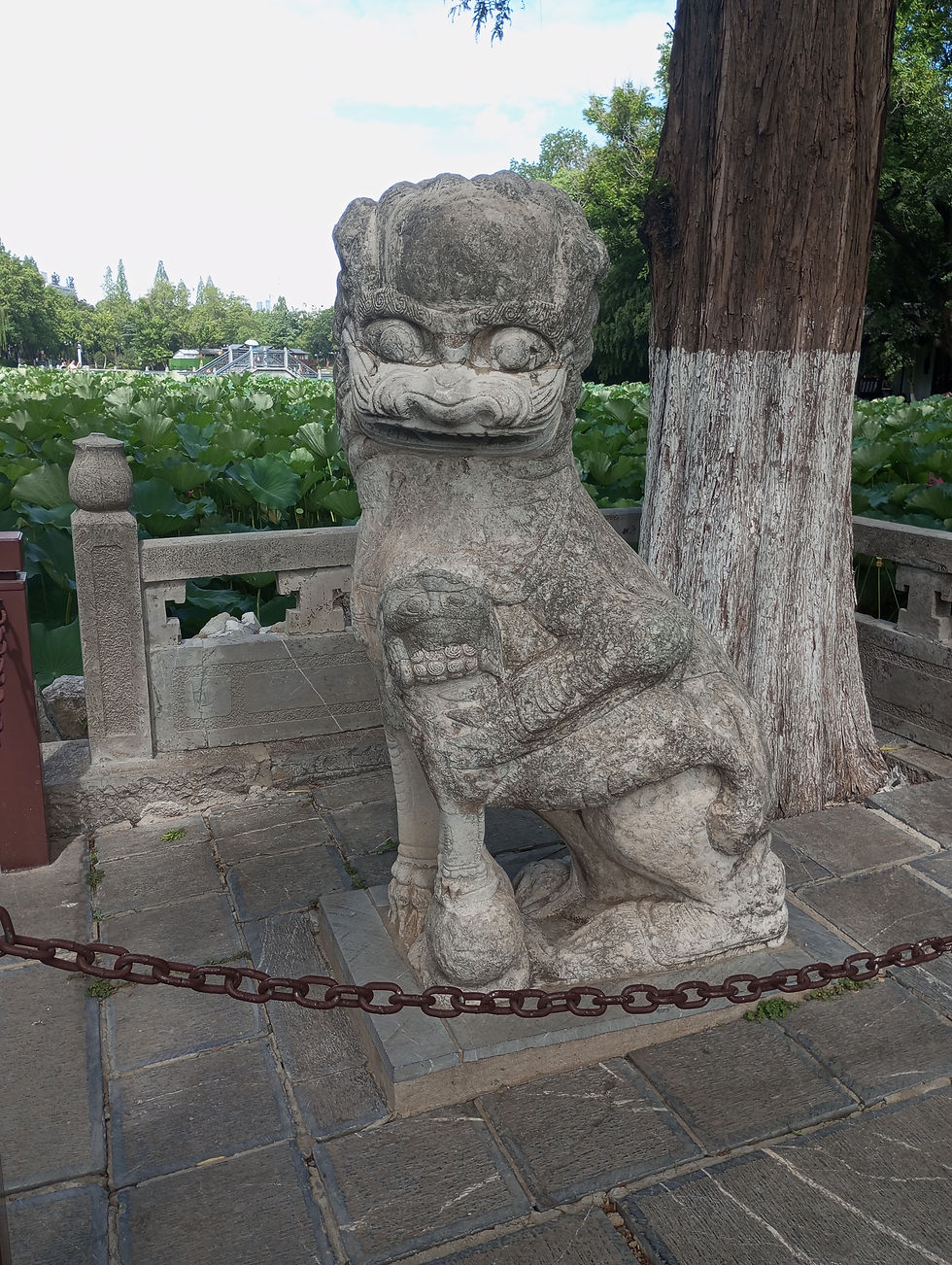
Of course visiting the temple requires the utmost respect. Let's not forget that it is a place of worship and there are always worshippers intent on praying inside.
The attention of the visitors, as soon as they enter the temple, is immediately attracted by the large, richly decorated censers that allow the worshippers to present their offerings during prayer. Beyond these, five towering golden statues face the visitors. They represent five men of solemn and authoritarian appearance. The central statue is the largest and the light fully illuminates its face, making its gold surface stand out. It is obviously Lord Bao himself, surrounded by four warriors, ready to fight for him and follow him faithfully even after death.

Three curious objects are displayed in a corner of the temple. They are equipped with sharp blades and used for the punishment of those found guilty of serious crimes. According to the legend, if the culprit was a man of the people, he had to be punished with the “guillotine” decorated with the head of a dog. The one with the tiger head was instead used for the officers and officials of the kingdom, while the most prestigious, with the dragon head, was dedicated to blue-blooded people.
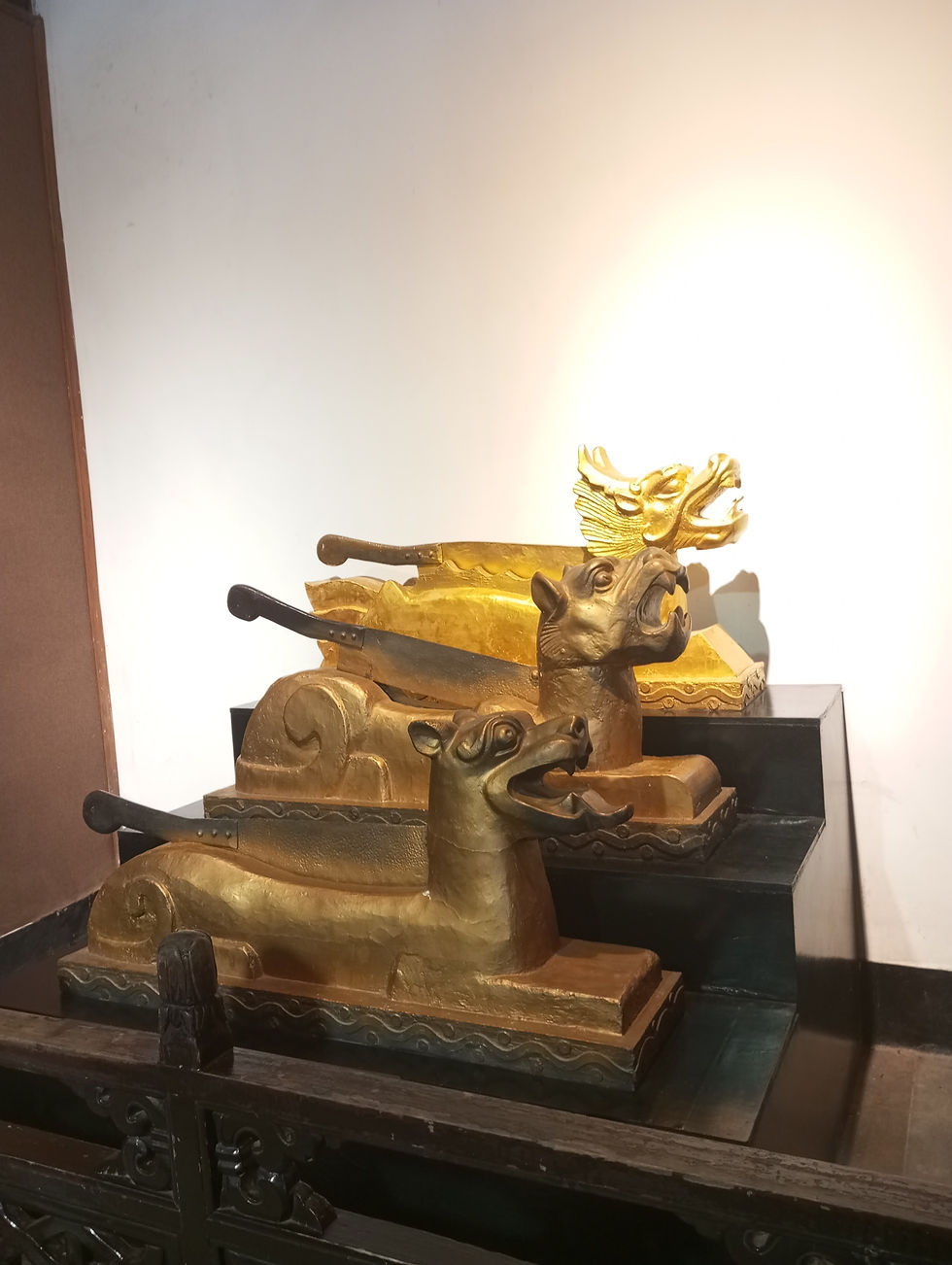
After leaving the temple, you will find on your left a bamboo grove. In the past, Lord Bao's birthplace stood there, but it was destroyed over the years. In its place, a building with a vaguely circular shape has now been erected, whose internal walls are decorated with relief images that summarize the life of Lord Bao and his most important works, from birth to death.
Then, on your right you will immediately come across the Lianquan well, guarded by stone lions and a golden dragon. According to the legend, if a corrupt official drinks water from this well, he will find it disgusting and feel sick soon after. On the contrary, if an honest official drinks it, he will feel it sweet and fresh.
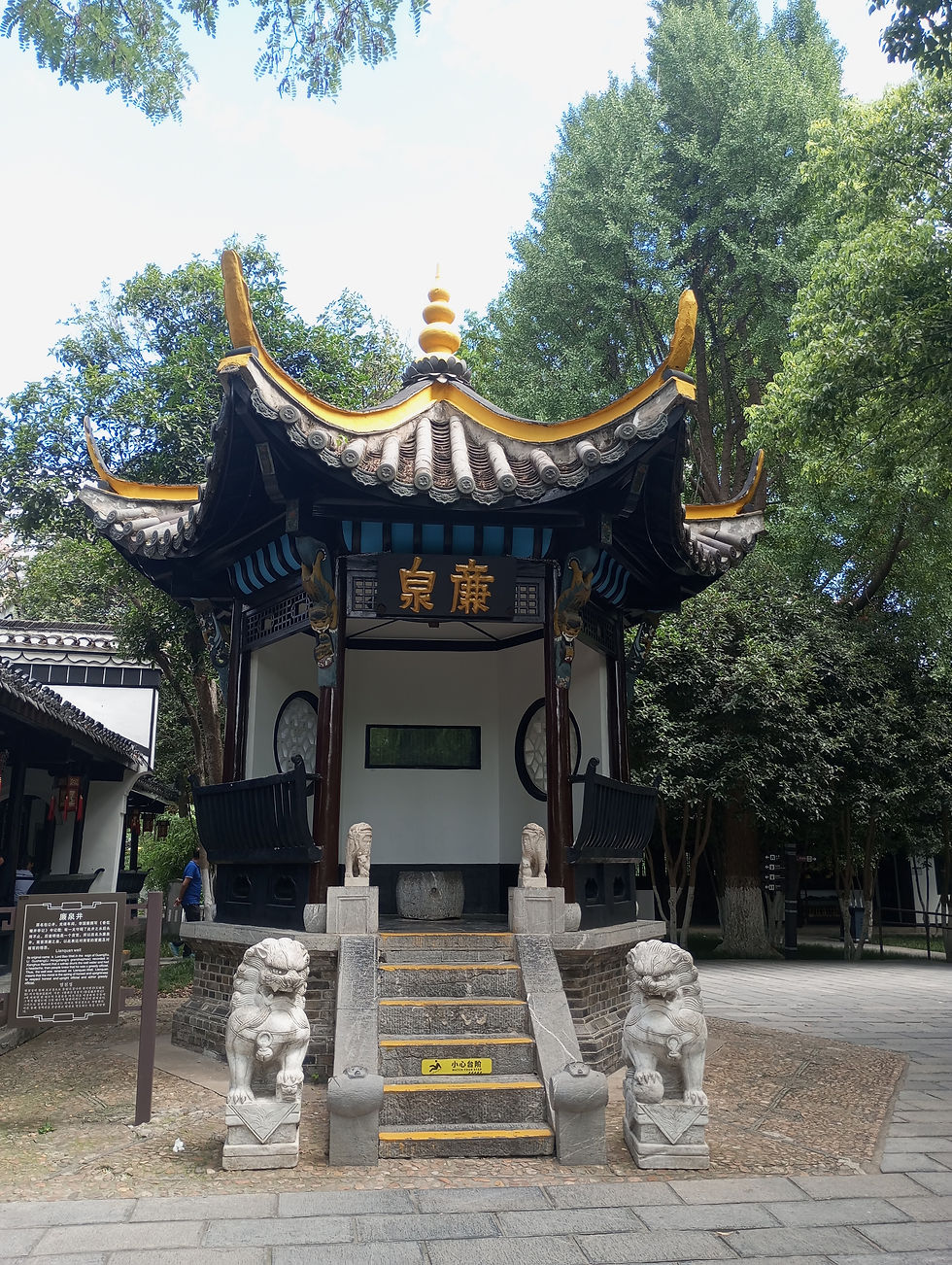
Continue with your visit and you will reach another building, used as a museum. Here visitors can read interesting explanations and anecdotes about Lord Bao's life, many of which are even translated into English (which can never be taken for granted in Hefei). The museum also features interactive stations, where the visitors (if they speak Chinese) can interact directly with Lord Bao and immerse themselves in his world, watching as a spectator some meetings with other imperial officials.
Once the exploration of the temple is finished, visitors can return to the mainland and follow a bright and fresh path among the trees, surrounded by lanterns and other evocative traditional Chinese decorations. At a certain point the visitor will find a stone staircase on his right, which will lead him to the entrance of two unmissable places. The first consists of the Qingfeng Pavilion, whose shapes bring us back to the illustrations of ancient Chinese legends.

The Pavilion has five floors, each of which is dedicated to a specific aspect of Lord Bao's work, such as his sense of justice, culture and loyalty to his family. Each floor presents exhibitions and interactive stations with which the visitor can delve deeper into these themes and discover more about Lord Bao's life. Unfortunately, most of the explanatory panels are not translated into English.
On the fifth floor there is the exit to the external balcony, from where you can enjoy an impressive view. Viewed from above, the classic forms of the park and its ancient structures contrast in a singular way with the gigantic modern skyscrapers that surround it. From the top of the Pavilion the sounds of heavy city traffic are audible again, although dampened by the strong wind that sometimes blows over the park. In this regard, you must be careful not to lose your hat or any other light object, which the wind hitting the top of the Pavilion could snatch from your hands!
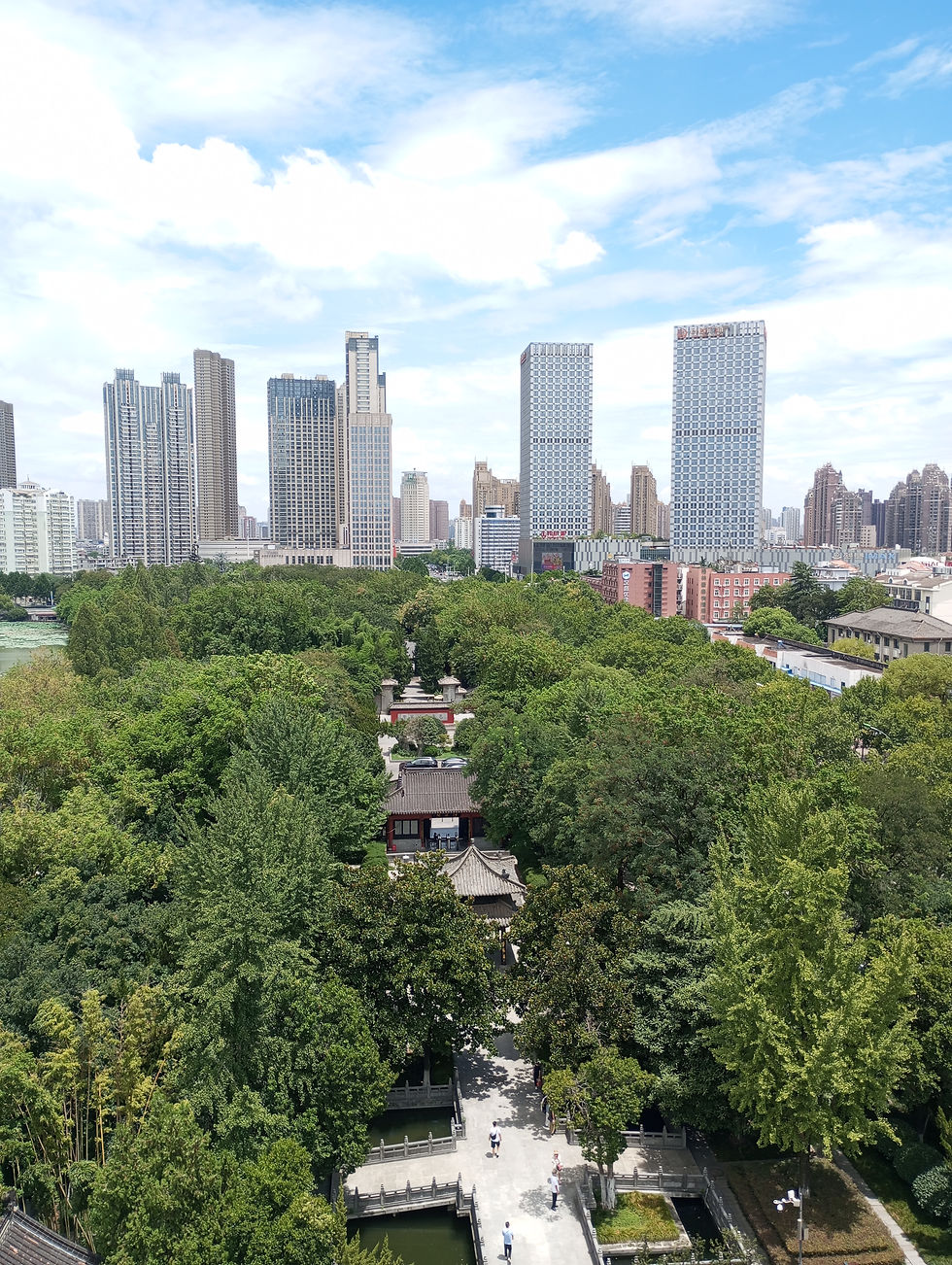
But let's get back down to earth, literally. Once you leave the Pavilion, you will be in front of the entrance to the cemetery area. Here Lord Bao and his family rest in peace, so visitors are expected to behave as respectfully and silently as possible.
The funerary stones of great personalities are guarded by legendary animals, such as the dragon and the turtle. Other statues along the route guard the rest of the dead: the tiger, the goat and also two human figures. They lead to a second small temple, where there is an imposing censer adorned with numerous golden dragons. The worshippers can offer incense sticks as a sign of prayer at this censer, or make further offerings by placing them on the three stone supports placed in front of each tomb.
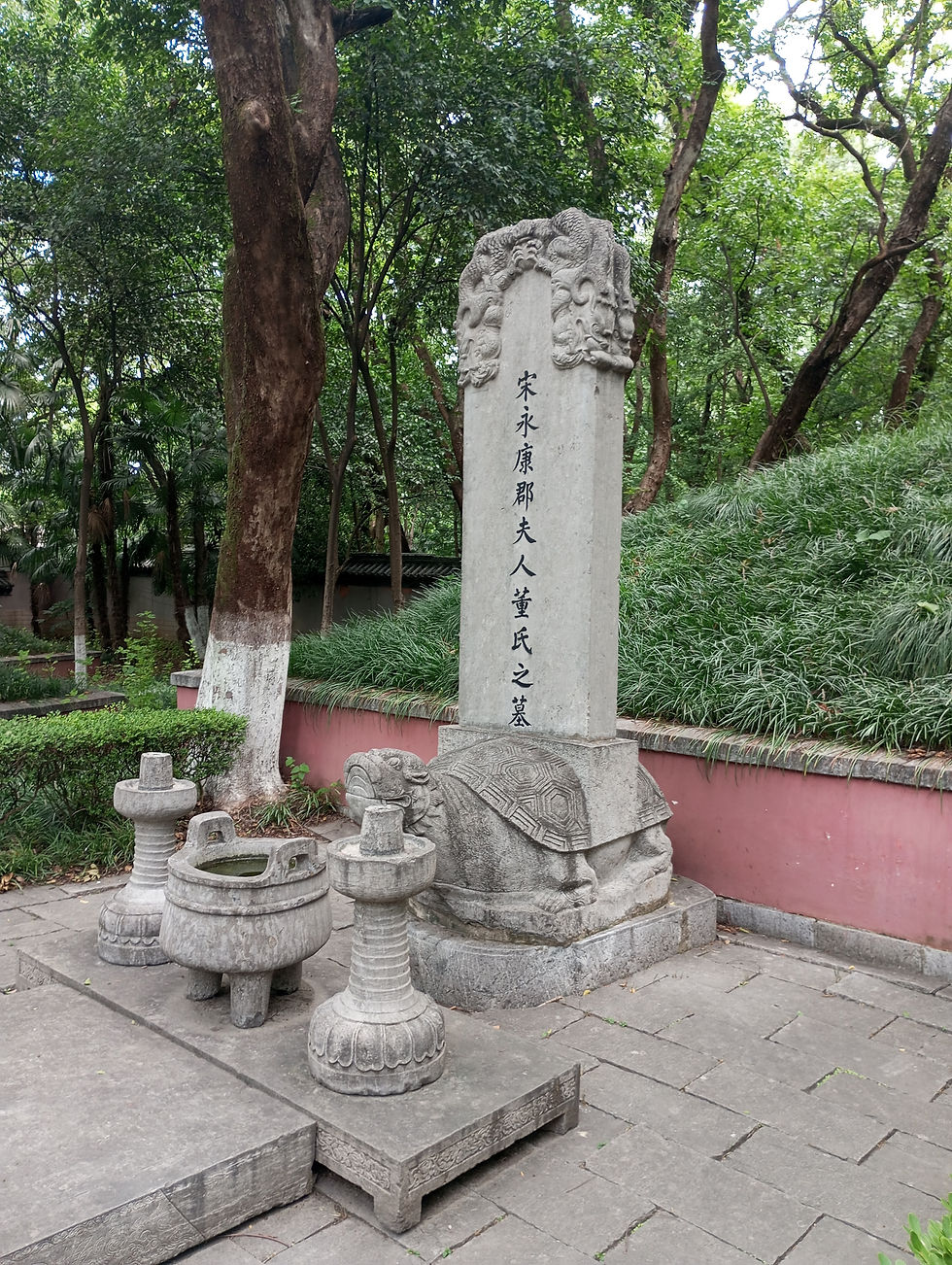
Lord Bao lies in an underground sepulchre accessible through a long tunnel, illuminated by wooden dragons holding up some lights. Their glow, however, covers a relatively limited area, meaning that it is necessary to proceed in the dim light, leaving behind the green light of the bamboo forest surrounding the entrance to the sepulchre. This is an unforgettable and absolutely suggestive experience, but it could be quite complicated to face for those suffering from claustrophobia.
After a curve, the tunnel continues deeper and deeper and the light becomes even softer. At the bottom, the visitor will find an antechamber with a large stone slab, placed horizontally on the ground. Above it is an inscription, facing upwards, that is, towards the gods. Beyond the slab, the real sarcophagus room opens up. There the precious remains of Lord Bao rest for eternity.

Before leaving the cemetery area, the visitor will find a small building. It is a small museum, but unfortunately its explanatory panels are not translated into English.
Let’s return to the path winding through the park. From here you immediately reach a stone bridge that leads you to the floating village, called Fuzhuang in Chinese. It is an island on the Baohe River on which graceful buildings have been built that mix the architectural style of older villages and the harmony of a lush garden. The inhabitants of Hefei seem to particularly appreciate the silence and peace that reign on this small island.
Some photos of Fuzhuang
It is clear that the aesthetic sense represents the dominant criterion with which the entire village was built. Here there are also some clubs and a very peculiar shop, where ladies can have their hair styled with rich clasps and rent traditional Chinese clothes, and then have an entire photographic set immersed in the evocative atmosphere of Fuzhuang.
An element that could intrigue European visitors is the presence of numerous bridges with a strange “zig-zag” shape. Chinese architecture often incorporates mythological elements and this represents just one of those cases. In fact, it was believed that evil spirits were only able to move in a straight line. Building a zig-zag bridge was a way to prevent evil spirits from reaching homes.

Returning to the mainland and leaving the floating village behind, you can conclude the tour of the park. It is a circular route, so it will be possible to return to the starting point by walking under the fresh shade of the trees. Remember to keep your eyes always wide open while enjoying the view that surrounds you, because even in the smallest things you can discover hidden treasures of the history and culture of this fascinating place.







Comments